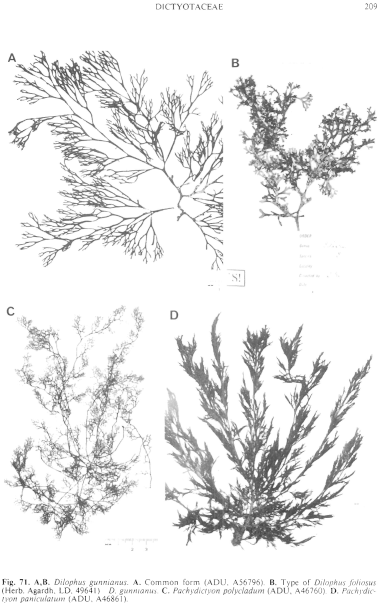|
|
|
|
|
|||||||||||
|
Electronic Flora of South Australia Species Fact Sheet
Phylum Phaeophyta – Order Dictyotales – Family Dictyotaceae – Tribe Dictyoteae
Thallus (Fig. 71D) medium to dark brown, 5–25 (–35) cm long, with axes usually 1–2 (–3) mm broad and bearing lateral, fastigiate tufts (Fig. 72F) of dichotomous, flattened, branchlets (300–) 400–1200 (–1500) µm broad, more or less complanate or becoming twisted, usually without proliferations (occasional specimens with numerous small proliferations). Apical cells hemispherical, protruding. Holdfast rhizoidal and usually with numerous descending, ligulate, multicellular, attachment fibres developing from up to 3 cm above the base, forming a mass 2–6 mm across; epiphytic on larger algae or occasionally epilithic. Cortical cells 10–20 µm across, L/B (1–) 2–3 (–4), not or vaguely corresponding to medullary cells; in mid and lower parts of the axes or larger branches the cortex becomes 3–5 cells thick (Fig. 72H) by largely periclinal divisions of the original cortical cells, around the whole of the axis. Medulla (Fig. 72G,H) one cell thick throughout. Hair tufts (Fig. 72F) scattered, hairs 10–15 µm in diameter.
Reproduction: Tetrasporangia (Fig. 72F,G) 80–130 µm in diameter, single or in small clusters, scattered along branches. Oogonial sori scattered, ovate to elongate-ovate, mostly 400–800 µm long and 200–400 µm broad, with 50–150 oogonia, each ovoid, 50–80 µm long and 30–40 µm in diameter. Antheridial sori (Fig. 72I,J) scattered, ovate, 500–80012m long and 200–350 µm across; antheridia 50–60 long and 15–22 µm in diameter.
Type from Picton (Bunbury), W. Aust. (Bunbury); lectotype in Herb. Agardh, LD, 49502.
Selected specimens: Point Moore, Geraldton, W. Aust., drift ( Womersley, 17.ix.1979; ADU, A51173). Cowaramup Bay, W. Aust., 2–3 m deep (Clarke & Engler, 1.ix.1979; ADU, A50651). Point Sinclair, S. Aust., drift ( Womersley, 25.i.1951; ADU, A13669). Point Avoid, S. Aust., drift (Womersley, 2.xii.1975; ADU, A46861). Wanna, S. Aust., upper sublittoral (Gordon, 15.x.1968; ADU, A32634). Brighton, S. Aust., drift (Bienert, 12.xi.1965; ADU, A29663). Vivonne Bay, Kangaroo I., S. Aust., 3–6 m deep on jetty piles (Kraft, t, 15.iv.1973; ADU, A43709). Carpenter Rocks, S. Aust., upper sublittoral pools on fucoids ( Womersley, 5.ii.1970; ADU, A35 178-"Marine Algae of southern Australia" No.36). Point Roadknight, Vic., drift (Womersley, 22.i.1967; ADU, A31513). Hinders, Vic., upper sublittoral ( Womersley, 18.i.1967; ADU, A31799). Guyton Point, Robbins I., Tas., upper sublittoral (Wollaston & Mitchell, 23.ii.1964; ADU, A27609). Great Taylor Bay, Bruny I., Tas., 1–2 m deep (Shepherd, 14.ii.1972; ADU, A42136).
Distribution: From Geraldton and East Wallaby I., Houtman Abrolhos, W. Aust. around southern Australia and Tasmania to Sydney, N.S.W. (Borowitzka et al. 1982, p. 35).
Taxonomic notes: Pachydictyon paniculatum is one of the commonest species of Dictyotaceae along southern Australia, epiphytic on a variety of larger algae in the upper sublittoral under moderate to strong water movement. It differs from P. polycladum in its larger, broader, thallus, the more fastigiate branching, and in its hosts and habitat.
References:
BOROWITZKA, M.A., KING, R.J. & LARKUM, A.W.D. (1982). Field guide to the marine plants of New South Wales. Chlorophyta, Phaeophyta, and Seagrasses. (Privately publ., Sydney.)
WOMERSLEY, H.B.S. (1967). A critical survey of the marine algae of southern Australia. II. Phaeophyta. Aust. J. Bot. 15, 189–270.
The Marine Benthic Flora of Southern Australia Part II complete list of references.
Publication:
Womersley, H.B.S. (14 December, 1987)
The Marine Benthic Flora of Southern Australia
Part II
©Board of the Botanic Gardens and State Herbarium, Government of South Australia
Illustrations in Womersley Part II, 1997: FIGS 71D, 72 F–J.

Figure 71 enlarge
Fig. 71. A,B. Dilophus gunnianus. A. Common form (ADU, A56796). B. Type of Dilophus foliosus (Herb. Agardh, LD, 49641)=D. gunnianus. C. Pachydictyon polycladum (ADU, A46760). D. Pachydictyon paniculatum (ADU, A46861).

Figure 72 enlarge
Fig. 72. A–E. Pachydictyon polycladum (ADU, A16099). A. Lateral branch system with tetrasporangia and hair tufts below branchings. B. Transverse section of branch with an undivided sporangium. C. Transverse section of older axis with multilayered cortex. D. Upper branches of plant with oogonia. E. Transverse section of branch with oogonial sorus. F–J. Pachydictyon paniculatum (F,G, ADU, A29663; H,J, ADU, A43709; I, ADU, A32634). F. Lateral branch system with tetrasporangia and hair tufts. G. Transverse section of branch with tetrasporangia. H. Transverse section of older axis with multilayered cortex. I. Upper branches of plant with antheridial sori. J. Transverse section of branch With antheridial sorus. K,L. Lobospira bicuspidata (ADU, A42264). K. Apex of axis with apical (a.m.) and lateral (1.m.) meristems and two laterals, the right-hand one becoming bicuspid. L. Transverse section of a lateral with undivided sporangia.

|
Email Contact: State Herbarium of South Australia |

|